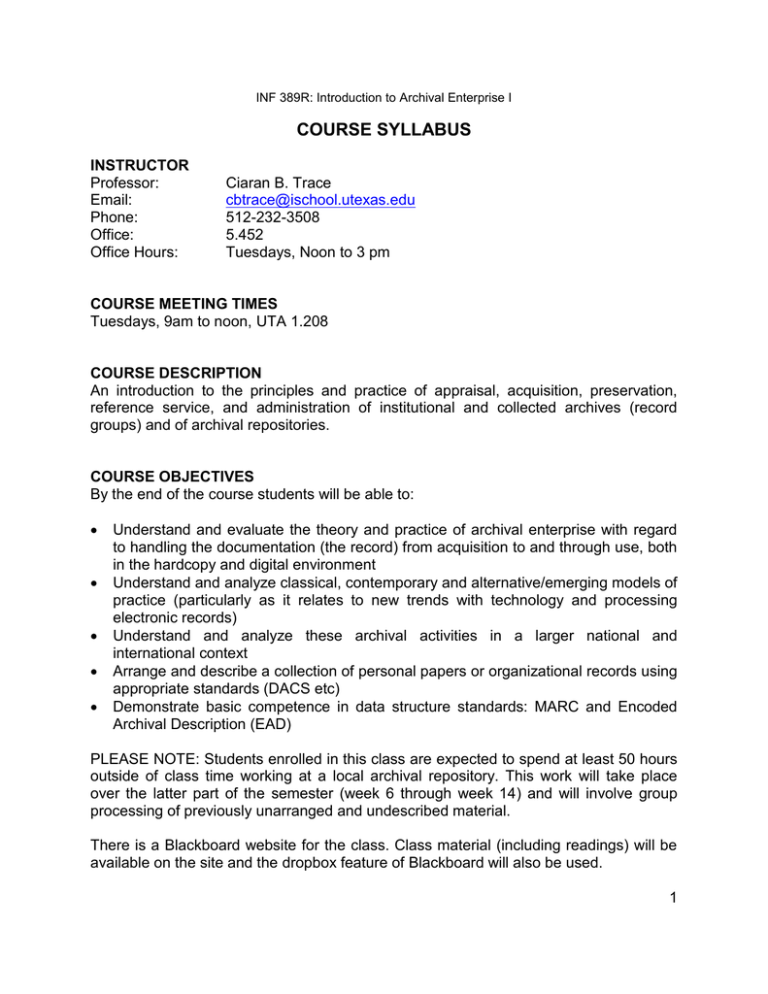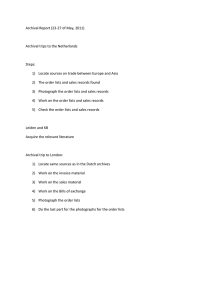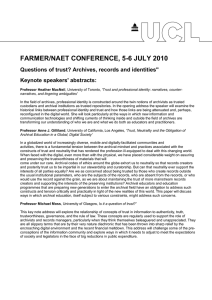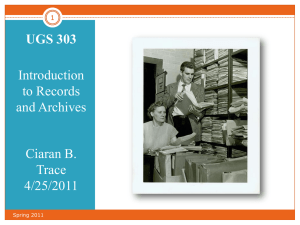INF 389R.docx
advertisement

INF 389R: Introduction to Archival Enterprise I COURSE SYLLABUS INSTRUCTOR Professor: Email: Phone: Office: Office Hours: Ciaran B. Trace cbtrace@ischool.utexas.edu 512-232-3508 5.452 Tuesdays, Noon to 3 pm COURSE MEETING TIMES Tuesdays, 9am to noon, UTA 1.208 COURSE DESCRIPTION An introduction to the principles and practice of appraisal, acquisition, preservation, reference service, and administration of institutional and collected archives (record groups) and of archival repositories. COURSE OBJECTIVES By the end of the course students will be able to: Understand and evaluate the theory and practice of archival enterprise with regard to handling the documentation (the record) from acquisition to and through use, both in the hardcopy and digital environment Understand and analyze classical, contemporary and alternative/emerging models of practice (particularly as it relates to new trends with technology and processing electronic records) Understand and analyze these archival activities in a larger national and international context Arrange and describe a collection of personal papers or organizational records using appropriate standards (DACS etc) Demonstrate basic competence in data structure standards: MARC and Encoded Archival Description (EAD) PLEASE NOTE: Students enrolled in this class are expected to spend at least 50 hours outside of class time working at a local archival repository. This work will take place over the latter part of the semester (week 6 through week 14) and will involve group processing of previously unarranged and undescribed material. There is a Blackboard website for the class. Class material (including readings) will be available on the site and the dropbox feature of Blackboard will also be used. 1 INF 389R: Introduction to Archival Enterprise I COURSE ASSIGNMENTS AND WEIGHTS 1. Records of the Texas Brewers Institute (TBI) (25%) 1A. Arrangement of records of the Texas Brewers Institute (TBI) (5% - Due Week 4: Tuesday, September 20th, 2011). The records are contained in a packet provided by the instructor. You are to formulate an organization for the documents identifying the groupings into which you would segregate the material. Hand in an outline showing how you have: [1] grouped the materials and [2] ordered the units to four levels below the fonds (subgroups, series, subseries, files). In parentheses, indicate the inclusive dates and number of items for each unit of documentation. This is not to be an item list, though you may identify one or more archival units that consist of a single item. This document should be submitted in electronic format to the class Blackboard dropbox and a paper copy should be brought to class. For additional information about this assignment please see the course guidebook. 1B. Description of the TBI records (10% - Due Week 6: Tuesday, October 4th, 2011). Prepare (1) an administrative history, (2) a scope and content note, and (3) a system of arrangement note for the Brewers records. The third element of the archival inventory of the Brewers records—the physical grouping and ordering of the material—will be provided by the instructor as the solution to assignment #1A. This document should be submitted in electronic format to the class Blackboard dropbox and a paper copy should be brought to class. For additional information about this assignment please see the course guidebook. 1C. A MARC Record for the TBI Records (5% - Due Week 7: Tuesday, October 11th, 2011). The purpose of this assignment is to have you connect specific bits of information from the archival inventory with the appropriate MARC fields and subfields. Detailed information about how to complete the MARC assignment can be found in the course guidebook. 1D. An EAD Finding Aid for the TBI Records (5% - Due Week 7: Tuesday, October 11th, 2011). The purpose of this assignment is to have you use an XML editor and the EAD DTD, and to connect specific bits of information from the archival inventory with the appropriate EAD elements and attributes. Detailed information about how to complete the EAD assignment can be found in the course guidebook. The EAD and MARC record should be submitted in electronic format to the class Blackboard dropbox. 2. Processing a body of previously unarranged and undescribed material in an archival repository (65%) 2 INF 389R: Introduction to Archival Enterprise I In this assignment you will work in groups to arrange and describe a collection of personal papers or organizational records using appropriate standards (DACS etc). Another purpose of the project is to give you an opportunity to work under, and to observe, the staff of a functioning archives. You should plan to spend approximately 50 hours outside of class to complete this assignment. Project assignments will be announced by week four. Prior to this, arrangements will be made for students to receive collection descriptions and students will be given the opportunity to rate their interest in processing these collections for the semester project. While every effort will be made to honor these choices students will be assigned to other collections if necessary. You will work in groups of from two to five (preferably 3-4) persons. In completing this assignment you will produce: (2A.) Appraisal Report and Processing Plan (20% – Due Week 8: Tuesday, October 18th, 2011) (2B.) Inventory of your body of papers or records (35% - Due Week 11: Tuesday, November 8th, 2011) (2C.) EAD Finding Aid (10% - Due Week 14: Tuesday, November 29th, 2011) I will meet with each group in the presence of its body of material during the period of October 24th through October 29th, 2011 on a schedule established by week eight. For this meeting, which lasts about an hour and a half, each group is to bring a printed copy of their ARPP (including a written outline of the arrangement (to the subseries level) proposed for the records). We will discuss the ARPP and in particular the arrangement you have formulated. Along with the written assignments, to fulfill the requirements of the project, after our meeting you are to do the following in the repository: (1) sort the material into the arrangement upon which we have agreed, (2) put it in appropriate housing, and, (3) as time permits, prepare folder labels. Because the inventory is to be structured in the form prescribed by the repository in which you work, the configuration of the elements may vary from what we discuss in class. If the repository form does not give sufficient opportunity for you to convey all of the information that you think should be presented, or if it requires you to present your data in a way that you feel differs markedly from the generic format used in this class, attach a supplementary document to the copies you hand in explaining how you would have done the work had you been able to structure the inventory in the manner you thought appropriate. One convenient way to provide this information is to use the “track changes” feature in Word to insert commentary. The goal is to demonstrate that you are well grounded in the kinds of and distinctions between kinds of information essential to a good archival inventory. Two copies of each of the three written parts of this assignment are to be turned in: 1. An electronic copy to be submitted via Blackboard 2. A paper copy for my records. 3 INF 389R: Introduction to Archival Enterprise I Evaluation: Giving appropriate credit for individual contribution to group projects is difficult since the instructor can have little knowledge of the functioning of each group. To facilitate accurate grading of the project, I ask that at the end of the semester each student submit (via the Blackboard dropbox) a confidential memo crediting each member of the group, including yourself, with a percentage of contribution to the whole. The percentages must total 100. In addition, you should comment upon the work of any group member whose outstanding performance should be recognized or whose failure to contribute appropriately to the work of the group has affected the product of the group on which all are graded. As appropriate, these observations will be considered in assigning the class participation grade. Additional information about how to complete this assignment can be found in the course guidebook. 3. (10%) Class participation. In grading for class participation I will take into consideration student attendance, each individual’s contribution to class discussions, use of the resources posted to Blackboard, and engagement with the process of working on the processing assignment. PLEASE NOTE: Assignments are due by 8am on the due date. I will use the following schedule as the basis for calculating grades: A = 95-100, A- = 89-94, B+ = 84-88, B = 79-83, B- = 74-79, C+ = 69-73, C = 64-68, C- = 60-63, F = <60. For each day that an assignment is late, ten percent of the possible points will be deducted from the score. REQUIRED TEXTBOOKS Kathleen D. Roe, Arranging and Describing Archives and Manuscripts (Chicago: Society of American Archivists, 2005). Available from the Society of American Archivists, http://www.archivists.org (List price: $49.00; SAA Member price: $35.00) Mary Jo Pugh, Providing Reference Services for Archives and Manuscripts (Chicago: Society of American Archivists, 2005). Available from the Society of American Archivists, http://www.archivists.org (List price: $49.00; SAA Member price: $35.00) Describing Archives: A Content Standard (Chicago: Society of American Archivists, 2007). Cited in syllabus as DACS. Available from the Society of American Archivists, http://www.archivists.org (List price: $49.00; SAA Member price: $35.00) Mary Lynn Ritzenthaler and Diane Vogt-O’Connor, Photographs: Archival Care and Management (Chicago: Society of American Archivists, 2006). Available from the Society of American Archivists, http://www.archivists.org (List price: $84.95; SAA Member price: $59.95) ANNOUNCEMENTS 4 INF 389R: Introduction to Archival Enterprise I University of Texas Honor Code The core values of The University of Texas at Austin are learning, discovery, freedom, leadership, individual opportunity, and responsibility. Each member of the university is expected to uphold these values through integrity, honesty, trust, fairness, and respect toward peers and community. Documented Disability Statement The University of Texas at Austin provides upon request appropriate academic accommodations for qualified students with disabilities. For more information, contact Services for Students with Disabilities at 471-6259 (voice) or 232-2937 (video phone) or http://www.utexas.edu/diversity/ddce/ssd Use of E-Mail for Official Correspondence to Students E-mail is recognized as an official mode of university correspondence; therefore, you are responsible for reading your e-mail for university and course-related information and announcements. You are responsible to keep the university informed about changes to your e-mail address. You should check your e-mail regularly and frequently—I recommend daily, but at minimum twice a week—to stay current with university-related communications, some of which may be time-critical. You can find UT Austin’s policies and instructions for updating your e-mail address at http://www.utexas.edu/its/policies/emailnotify.php Religious Holy Days By UT Austin policy, you must notify me of your pending absence at least fourteen days prior to the date of observance of a religious holy day. If you must miss a class, an examination, a work assignment, or a project in order to observe a religious holy day, I will give you an opportunity to complete the missed work within a reasonable time after the absence. Use of Blackboard in Class In this class I use Blackboard - a Web-based course management system with password-protected access at http://courses.utexas.edu - to distribute course materials, to communicate and collaborate online, to post announcements, and to submit assignments. You can find support in using Blackboard at the ITS Help Desk at 475-9400, Monday through Friday, 8 a.m. to 6 p.m. COURSE SCHEDULE Week One (Tuesday, August 30th, 2011) Introduction and Overview of Records, Archives, and the Archival Profession 5 INF 389R: Introduction to Archival Enterprise I Gregory S. Hunter, Developing and Maintaining Practical Archives, (New York: NealSchuman Publishers, 2003), pp. 1-20 (“Introduction to Archives and Manuscripts”). James M. O'Toole, Understanding Archives and Manuscripts (Chicago: Society of American Archivists, 1990) ch. 2 (“History of Archives and the Archives Profession”). Luke Gilliland-Swetland, “Provenance of a Profession: The Permanence of the Public Archives and Historical Manuscript Tradition in American Archival History,” American Archivist (Spring 1991): 160-175. Bekir Kemal Ataman, “Requirements for Information Professionals in a Digital Environment: Some Thoughts,” Program: Electronic Library and Information Systems 43(2) (2009): 215 - 228. Week Two (Tuesday, September 6th, 2011) History, Definitions, Concepts and Models (record, provenance, original order, evidential and informational value, authenticity and reliability, paradigms, models of records and recordkeeping, OAIS) Shelley Sweeney, “The Ambiguous Origins of the Archival Principal of Provenance,” Libraries and the Cultural Record 43 (2) (2008): 193-213. Luciana Duranti, “Diplomatics,” Encyclopedia of Library and Information Science (New York, Basel, Hong Kong: Marcel Dekker, INC.), in press. Geoffrey Yeo, “Concepts of Record (1): Evidence, Information, and Persistent Representations,” American Archivist 70 (Fall/Winter 2007): 315-343. Geoffrey Yeo, “Concepts of Record (2): Prototypes and Boundary Objects,” American Archivist 71 (1) (Summer 2008): 118-143. Susan Thomas and Janette Martin, “Using the Papers of Contemporary British Politicians as a Testbed for the Preservation of Digital Personal Archives,” Journal of the Society of Archivists 27 (1) (April 2006): 29-56. Paradigm Project, Workbook on Digital Private Papers 2005-2007. Read section 01 (Introduction), http://www.paradigm.ac.uk/workbook/ Week Three (Tuesday, September 13th, 2011) Processing - Arrangement (includes lab) T. R. Schellenberg, “Archival Principles of Arrangement,” in A Modern Archives Reader, edited by Maygene F. Daniels and Timothy Walch, (Washington, D.C.: National Archives and Records Service, 1984), 149-161. Oliver W. Holmes, “Archival Arrangement--Five Different Operations at Five Different Levels,” in A Modern Archives Reader, edited by Maygene F. Daniels and Timothy Walch (Washington, D.C.: National Archives and Records Service, 1984), 162-180. Kathleen D. Roe, Arranging and Describing Archives and Manuscripts (Chicago: Society of American Archivists, 2005), pp. 1-70 and pp.119-130. 6 INF 389R: Introduction to Archival Enterprise I Frederick M. Miller, Arranging and Describing Archives and Manuscripts (Chicago: Society of American Archivists, 1990), chapter 7. Jennifer Meehan, “Making the Leap from Parts to Whole: Evidence and Inference in Archival Arrangement and Description,” American Archivist 72 (1) (Spring/Summer 2009): 72-90. Mary Lynn Ritzenthaler and Diane Vogt-O’Connor, Photographs: Archival Care and Management, “Accessioning and Arrangement.” Week Four (Tuesday, September 20th, 2011) Processing – Description (includes discussion of Brewers Arrangement) ASSIGNMENT DUE: TBI Arrangement Kathleen D. Roe, Arranging and Describing Archives and Manuscripts (Chicago: Society of American Archivists, 2005), 71-97 and 131-174. DACS: Describing Archives: A Content Standard, read v-xxi and review parts I, II, and III. Mark A. Greene and Dennis Meissner, “More Product, Less Process: Revamping Traditional Archival Processing,” American Archivist 68 (2) (Fall/Winter 2005): 208263. Mary Lynn Ritzenthaler and Diane Vogt-O’Connor, Photographs: Archival Care and Management, “Description and Cataloging.” Michele Light and Tom Hyry, “Colophons and Annotations: New Directions for the Finding Aid,” American Archivist 65 (Fall/Winter 2002): 216-230. Paradigm Project, Workbook on Digital Private Papers 2005-2007. Read section 06 (Arranging and Cataloging Digital and Hybrid Archives), http://www.paradigm.ac.uk/workbook/ Sarah Kim, Lorraine A. Dong, and Megan Durden, “Automated Batch Archival Processing” Preserving Arnold Wesker’s Digital Manuscripts,” Archival Issues 30 (2) (2006): 91-106. Week Five (Tuesday, September 27th, 2011) Technology and the Transformation of Archival Description (includes discussion of TBI arrangement and DACS and MARC Lab) Daniel V. Pitti, “Technology and the Transformation of Archival Description,” Journal of Archival Organization 3 (2/3) (2005): 9-22. Review the Library of Congress “Understanding MARC Bibliographic MachineReadable Cataloging” web site available at http://lcweb.loc.gov/marc/umb/ Review the University of Southern Mississippi MARC 21 tutorial available at http://www.lib.usm.edu/legacy/techserv/marc21_tutorial_ie/ and the Authority 7 INF 389R: Introduction to Archival Enterprise I Tutorial available at http://www.lib.usm.edu/legacy/techserv/auth_tutorial/ Look at “MARC 21 Concise Format for Bibliographic Data” available from the LOC website at http://www.loc.gov/marc/bibliographic/ecbdhome.html DCC Digital Curation Manual, “Installment on Archival Metadata” (2006). http://www.dcc.ac.uk/resources/curation-reference-manual/completed-chapters Open Source Software Solutions: o Archon, http://www.archon.org/index.php o Archivists’ Toolkit, http://archiviststoolkit.org/ Other Readings Chapters 1-3 and Appendix A of “Descriptive Metadata Guidelines for RLG Cultural Materials” http://www.rlg.org/en/pdfs/RLG_desc_metadata.pdf Larry Weimer, Pathways to Provenance: DACS and Creator Descriptions,” Journal of Archival Organization 5 (1/2) (2007): 33-48. Week Six (Tuesday, October 4th, 2011) Technology and the Transformation of Archival Description (includes EAD Lab) ASSIGNMENT DUE: TBI Description BEGIN WORK ON GROUP PROCESSING PROJECT – Make sure to read through the Processing Manual and Appendices sections of the Guidebook! EAD: Encoded Archival Description Version 2002 Official Site (EAD Official Site, Library of Congress) http://www.loc.gov/ead/ o Encoded Archival Description Tag Library, Version 2002. http://www.loc.gov/ead/tglib/index.html OCLC Research Over, Under, Around, and Through: Getting Around Barriers to EAD Implementation, http://www.oclc.org/research/publications/library/2010/201004.pdf Week Seven (Tuesday, October 11th, 2011) Appraisal and discussion of Brewers Inventory ASSIGNMENT DUE: Brewers MARC and EAD Ole Kolsrud, “The Evolution of Basic Appraisal Principles - Some Comparative Observations,” American Archivist 55 (Winter 1992): 26-39. Terry Cook, “Mind Over Matter: Towards A New Theory of Archival Appraisal,” in Barbara L. Craig, ed., The Archival Imagination: Essays in Honour of Hugh A. Taylor (Ottawa: Association of Canadian Archivists, 1992), pp. 38-70. 8 INF 389R: Introduction to Archival Enterprise I Carol Couture, “Archival Appraisal: A Status Report,” Archivaria 59 (Spring 2005): 83-108. Ciaran B. Trace, “On or Off the Record? Notions of Value in the Archive,” in Currents of Archival Thinking, eds. Terry Eastwood and Heather MacNeil (Santa Barbara, Calif.: Libraries Unlimited, 2010): 47-68. F. Gerald Ham, Selecting and Appraising Archives and Manuscripts (Chicago: Society of American Archivists, 1992), chapters 6, 7, 10. Paradigm Project, Workbook on Digital Private Papers 2005-2007. Read section 04 (Appraisal and Disposal) http://www.paradigm.ac.uk/workbook/ Week Eight (Tuesday, October 18th, 2011) Records Technology and Preservation ASSIGNMENT DUE: Appraisal Report and Processing Plan Mary Lynn Ritzenthaler and Diane Vogt-O’Connor, Photographs: Archival Care and Management, “Photographs in Archival Collections,” “History of Photographic Processes,” “Preservation.” Robyn Gamble and Louise Curham, “Sound Recordings,” in Keeping Archives, third edition (Canberra: Australian Society of Archivists, 2008), 551-590. Louise Curham and Robyn Gamble, “Moving Images,” in Keeping Archives, third edition (Canberra: Australian Society of Archivists, 2008), 591-624. Gregory S. Hunter, “Digital Records,” in Developing and Maintaining Practical Archives, Second Edition (New York: Neal-Schuman Publishers, 2004) pp. 237-283. Cornell University Tutorial, “Digital Preservation Management: Implementing Shortterm Strategies for Long-term Problems,” http://www.icpsr.umich.edu/dpm/dpmeng/eng_index.html Paradigm Project Workbook on Digital Private Papers 2005-2007. Read sections 05 (Administrative and Preservation Metadata) and 08 (Digital Preservation Strategies). http://www.paradigm.ac.uk/workbook/ Week Nine (Tuesday, October 25th, 2011) Computer Boot Camp- Hardware and Operating Systems Project group meetings and visits Ciaran B. Trace, ““Beyond the Magic to the Mechanism: Computers, Materiality and What it Means for Records to Be “Born Digital.” Forthcoming in Archivaria. William Saffady, “Storage Media for Electronic Recordkeeping,” in Managing Electronic Records, 4th edition (New York.: Neal-Schuman Publishers, 2009): 23-57. Henry Lowood, “The Hard Work of Software History,” RBM: A Journal of Rare 9 INF 389R: Introduction to Archival Enterprise I Books, Manuscripts, and Cultural Heritage 2 (2) (Fall 2001): 141-61. Week Ten (Tuesday, November 1st, 2011) Computer Boot Camp – An Introduction to Digital Forensics Matthew G. Kirschenbaum, Richard Ovenden, and Gabriela Redwine, “Digital Forensics and Born-Digital Content in Cultural Heritage Collections,” Council on Library and Information Resources (CLIR) report, December 2010. http://www.clir.org/pubs/abstract/pub149abst.html Jeremy Leighton John, “Adapting Existing Technologies for Digitally Archiving Personal Lives: Digital Forensics, Ancestral Computing, and Evolutionary Perspectives and Tools,” Paper presented at iPRES 2008: The Fifth International Conference on Preservation of Digital Objects, London, UK, September 29-30, 2008. http://www.bl.uk/ipres2008/presentations_day1/09_John.pdf Mathew G. Kirschenbuam et al., “Digital Materiality: Preserving Access to Computers as Complete Environments,” Paper presented at iPRES 2009: The Sixth International Conference on Preservation of Digital Objects, London, UK, September 29-30, 2009. http://lib.stanford.edu/digital-forensics Karen Ballinger et al., “Digital Archaeology Lab Manual” (2011). https://pacer.ischool.utexas.edu/handle/2081/23283 Week Eleven (Tuesday, November 8th, 2011) Acquisition, Accessioning and Collection Development ASSIGNMENT DUE: Inventory/Finding Aid F. Gerald Ham, Selecting and Appraising Archives and Manuscripts (Chicago: Society of American Archivists, 1992), Chapters 3, 4, 5, 9. Virginia R. Stewart, “A Primer on Manuscript Field Work,” The Midwest Archivist 1 (2) (1976): 3-20. Mary Lynn Ritzenthaler and Diane Vogt-O’Connor, Photographs: Archival Care and Management, “Appraisal and Acquisitions.” Susan Davis, “Electronic Records Planning in “Collecting” Repositories,” American Archivist 71 (1) (Spring-Summer 2008): 167-189. Paradigm Project, Workbook on Digital Private Papers 2005-2007. Read sections 03 (Working with Record Creators), and 02 (Collection Development), http://www.paradigm.ac.uk/workbook/ Simson Garfinkel and David Cox. “Finding and Archiving the Internet Footprint,” paper, presented at the First Digital Lives Research Conference: Personal Digital Archives for the 21st Century, London, England, 9–11 February 2009. 10 INF 389R: Introduction to Archival Enterprise I Week Twelve (Tuesday, November 15th, 2011) Law and Ethics Copyright Term and the Public Domain Chart http://copyright.cornell.edu/resources/publicdomain.cfm Society of American Archivist, “Code of Ethics for Archivists” http://www.archivists.org/governance/handbook/app_ethics.asp Sara Hodson, “In Secret Kept, In Silence Sealed: Privacy in the Papers of Authors and Celebrities,” American Archivist 67 (2004): 194-211. Mary Lynn Ritzenthaler and Diane Vogt-O’Connor, Photographs: Archival Care and Management, “Legal and Ethical Issues of Ownership, Access and Usage.” Eric Ketelaar, “Archival Temples, Archival Prisons: Modes of Power and Protection,” Archival Science 2 (2002): 221-238. Randall C. Jimerson, “Archives for All: Professional Responsibility and Social Justice,” American Archivist 70 (2) (Fall/Winter 2007): 252-281. Verne Harris, “The Archive is Politics,” in Archives and Justice: A South African Perspective (Chicago: Society of American Archivists, 2007), 239-252. Week Thirteen (Tuesday, November 22nd, 2011) Access and Reference Mary Jo Pugh, Providing Reference Services for Archives and Manuscripts (Chicago: Society of American Archivists, 2005), chapters 3-9. Ciaran B. Trace, “For Love of the Game: An Ethnographic Analysis of Archival Reference Work,” Archives and Manuscripts 34 (1) (May 2006): 124-143. Wendy Duff and Allyson Fox, “You’re a Guide Rather than an Expert:” Archival Reference from an Archivist’s Point of View,” Journal of the Society of Archivists 27 (2) (October 2006): 129-153. Max Evans, “Archives of the People, by the People, For the People,” American Archivist 70 (2) (Fall-Winter 2007): 387-400. Magia G. Krause, “Learning in the Archives: A Report on Instructional Practices,” Journal of Archival Organization, 6 (4) (December 2008): 233 – 268. Mary Lynn Ritzenthaler and Diane Vogt-O’Connor, Photographs: Archival Care and Management, “Reference Services and the Research Room” and “Outreach: Public Programs, Public Relations, and Fund-Raising.” Week Fourteen (Tuesday, November 29th, 2011) Class Presentations and Course Wrap Up ASSIGNMENT DUE: Final Inventory/Finding Aid 11 INF 389R: Introduction to Archival Enterprise I ASSIGNMENT DUE: EAD Finding Aid ASSIGNMENT DUE: “My Contribution to the Processing Project” Memo Trudy Huskamp Peterson, “An Archival Bestiary,” American Archivist 54 (Spring 1991): 192-205. Groups should come to class prepared to make an informal, oral presentation (10 minutes) about the semester processing project. Presentations may include such topics as: 1) A brief description of the collection and its importance; 2) A summary of the problems you encountered in processing the collection and the strategies you devised during processing to solve these problems; 3) A discussion of how your understanding of the collection changed; 4) An assessment of the potential audience for the collection; and 5) A brief description of how you would have processed this collection if you had been following MPLP guidelines. 12




